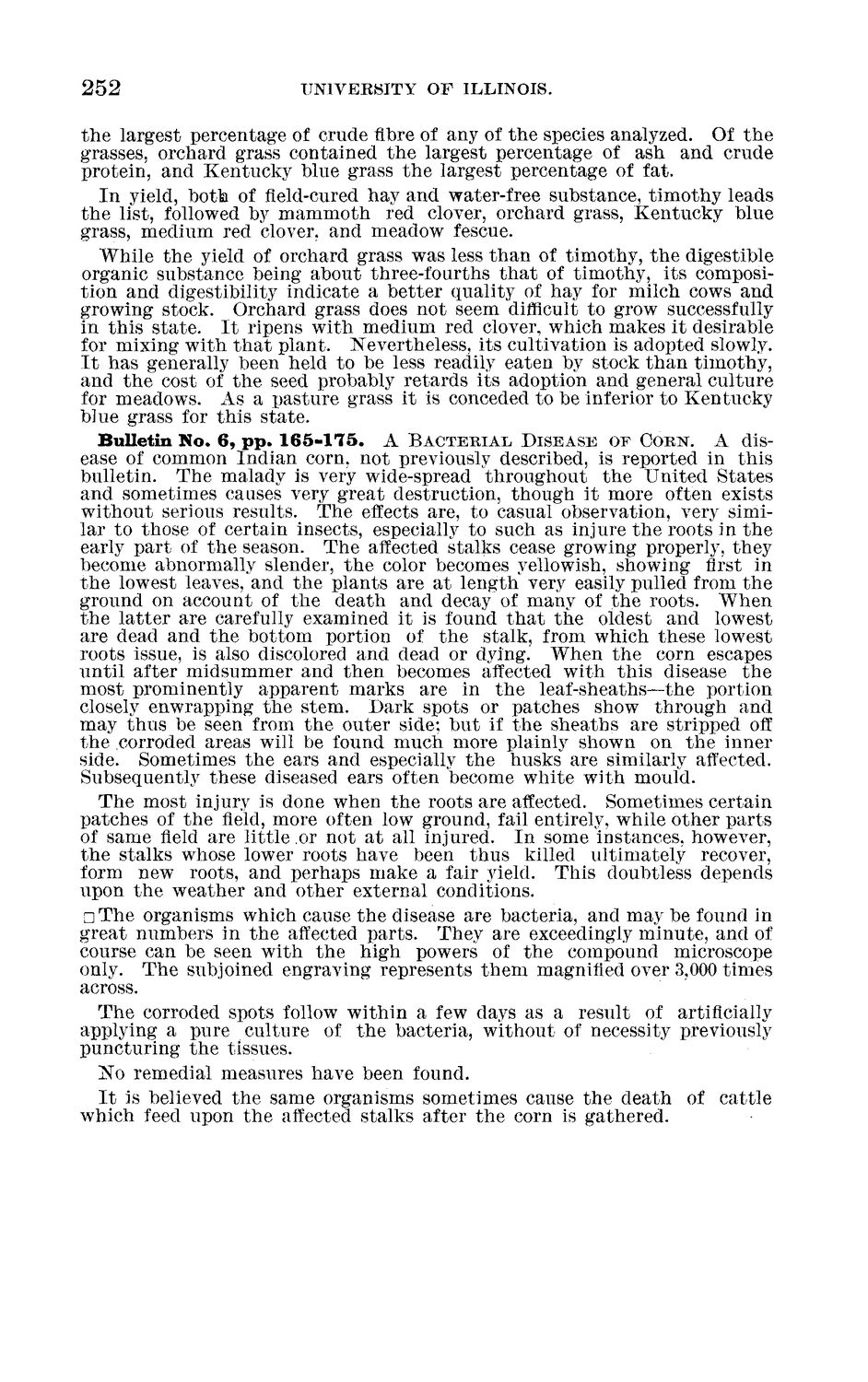| |
| |
Caption: Board of Trustees Minutes - 1890
This is a reduced-resolution page image for fast online browsing.

EXTRACTED TEXT FROM PAGE:
252 UNIVERSITY O F ILLINOIS. the largest percentage of crude fibre of any of the species analyzed. Of t h e grasses, orchard grass contained t h e largest percentage of ash and crude protein, and Kentucky blue grass t h e largest percentage of fat. In yield, both of field-cured hay and water-free substance, timothy leads the list, followed by mammoth red clover, orchard grass, Kentucky blue grass, medium red clover, and meadow fescue. While the yield of orchard grass was less than of timothy, the digestible organic substance being about three-fourths t h a t of timothy, its composition and digestibility indicate a better quality of hay for milch cows and growing stock. Orchard grass does not seem difficult to grow successfully in this state. I t ripens with medium red clover, which makes it desirable for mixing with t h a t plant. Nevertheless, its cultivation is adopted slowly. I t has generally been held to be less readily eaten by stock than timothy, and t h e cost of the seed probably retards its adoption and general culture for meadows. As a pasture grass it is conceded to be inferior to Kentucky blue grass for this state. Bulletin No. 6, pp. 1 6 5 - 1 7 5 . A BACTERIAL DISEASE OF CORN. A dis- ease of common Indian corn, not previously described, is reported in this bulletin. The malady is very wide-spread throughout t h e United States and sometimes causes very great destruction, though it more often exists without serious results. The effects are, to casual observation, very similar to those of certain insects, especially to such as injure the roots in t h e early part of the season. The affected stalks cease growing properly, they become abnormally slender, t h e color becomes yellowish, snowing first in the lowest leaves, and t h e plants are at length' very easily pulled from t h e ground on account of the death and decay of many of t h e roots. When the latter are carefully examined it is found t h a t the oldest and lowest are dead and t h e bottom portion of the stalk, from which these lowest roots issue, is also discolored and dead or dying. When the corn escapes until after midsummer and then becomes affected with this disease t h e most prominently apparent marks are in the leaf-sheaths—the portion closely enwrapping t h e stem. Dark spots or patches show through and may thus be seen from t h e outer side; b u t if t h e sheaths are stripped off the corroded areas will be found much more plainly shown on t h e inner side. Sometimes t h e ears and especially the husks are similarly affected. Subsequently these diseased ears often become white with mould. The most injury is done when the roots are affected. Sometimes certain patches of the field, more often low ground, fail entirely, while other parts of same field are little or not at all injured. I n some instances, however, the stalks whose lower roots have been thus killed ultimately recover, form new roots, and perhaps make a fair yield. This doubtless depends upon t h e weather and other external conditions. • The organisms which cause the disease are bacteria, and may be found in great numbers in t h e affected parts. They are exceedingly minute, and of course can be seen with t h e high powers of t h e compound microscope only. The subjoined engraving represents them magnified over 3,000 times across. The corroded spots follow within a few days as a result of artificially applying a pure culture of t h e bacteria, without of necessity previously puncturing the tissues. No remedial measures have been found. I t is believed the same organisms sometimes cause the death of cattle which feed upon the affected stalks after the corn is gathered.
| |